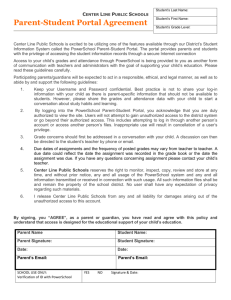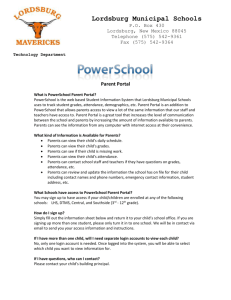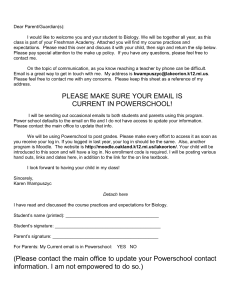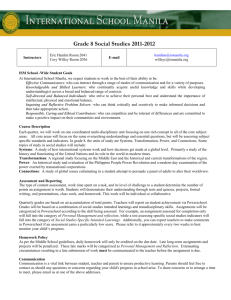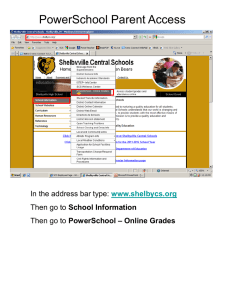Communications Best Practices Guide 2014
advertisement
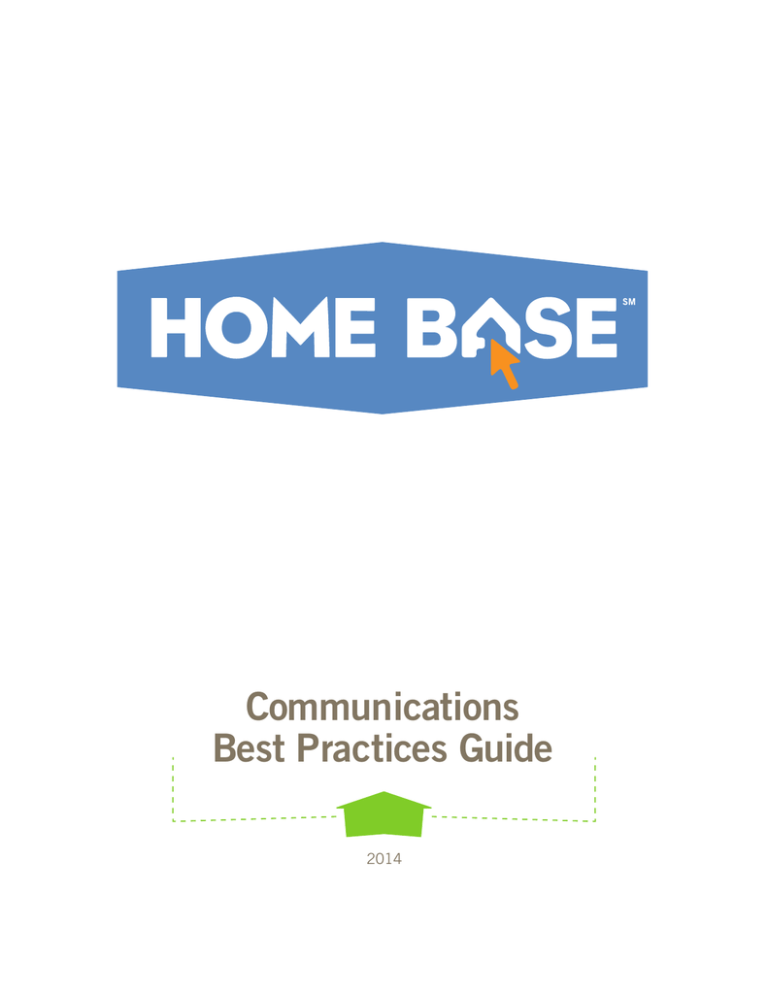
Communications Best Practices Guide 2014 Supporting Your Needs We are passionate about our students’ futures and are responsible for providing the direction to help them succeed. A massive undertaking like Home Base doesn’t come without difficulty and a magnitude of questions. This Best Practices Guide was created to support your communications. It includes: – a series of Q+A spearheaded by teachers, parents and public information officers, – tips from the field, which highlight experiences and insights from across the state, and – five keys to communicating Home Base. We will continue to email status updates and post training information on our website at ncpublicschools.org/homebase/. You can also follow us on twitter @NCHomeBase. the TIPS from FIELD Check out the “Tips from the Field” throughout this guide for great insights and fresh perspectives. 1 Answering Your Questions Q1: When I click Home Base on my school’s website, why does it take me to PowerSchool? Huh? A1: Home Base is home to a suite of web-based technology tools. It houses several major components, including PowerSchool, truenorthlogic, Schoolnet and OpenClass. Here’s a brief description of each software tool and how they interact: Data Input PowerSchool is a student information system, which enables our educators to make timely decisions that impact student performance while creating a collaborative environment for parents, teachers and students. PowerSchool replaces NC WISE and accommodates individual LEAs and charter schools with their own system, unlike the previous model. PowerSchool also will auto-populate students’ information to the rest of the suite below: truenorthlogic offers tools designed to support the ongoing professional growth of K-12 educational leaders and teachers. These tools run our Educator Effectiveness system, which includes both educator evaluation and professional development. Schoolnet is a suite of data-driven education tools for instructional improvement that aligns student assessment, curriculum and instruction with the NC Standard Course of Study; guides collaborative discussion and enables targeted instruction for every student. At your fingertips right now are 35,000+ assessment items and more than 10,000 aligned, instructional resources, all approved by the Department of Public Instruction. OpenClass is a dynamic learning management system that helps educators bring social learning and collaboration to their students. 2 Answering Your Questions Q2: Why are some people experiencing errors and others are not? A2: There are many variables that could affect your online experience with Home Base. – The system is inaccessible for users during scheduled maintenance weekends, which are needed to address system bugs or malfunctions plus add upgrades. These dates are scheduled with guidance from local educators and publicized in advance. Because we anticipate ever increasing use of the system, we are working with the vendor continually to assure capacity is there to meet the need. – Check with your school’s data manager to see that your school network is operating at the required bandwidth level. A low bandwidth may affect things like download speed and processing time. – All Microsoft operating systems should be running XP ver. 5.1 or later. All Mac operating systems should be running OS X 10.4 Tiger or later. – The more devices accessible to your students and teachers the better; just be sure they are operating on the latest browsers available (browser upgrades are typically free downloads). Also, check out free smartphone and tablet apps. the TIPS from FIELD Conduct a basic troubleshooting workshop for all staff, especially those administering online assessments. Designate a technical support person on your staff during testing periods. Official technical requirements can be found in the “Getting Ready for Home Base” section of the Home Base website, or download the PDF here. 3 Answering Your Questions Q3: Why don’t all schools have the same level of access to all portals? For instance, my school’s parent portal is not available. A3: It is up to each district and charter school to determine when to provide portal access. – Student access and parent access to Home Base can be activated at any time, but it’s up to the district to decide when you are ready. – School staff must check with your district data coordinator before giving student or parent access. Some districts may want to manage the process from the district level. – You can generate access IDs even if you are not yet ready to distribute them. Many schools have done this. – Parents can view information for one or more of their children with a single login. Before students can sign in to the Student Portal, they will need: - access that has been enabled by your district or school (system on and ready), - their school’s PowerSchool public portal URL, - their username (student web ID, issued by your school), and - their password (student web password, issued by your school). Before parents can sign in to the Parent Portal, they will need: - access that has been enabled by your district or school (system on and ready), - their school’s PowerSchool public portal URL, - their username (parent web ID, issued by your school), and - their password (parent web password, issued by your school). the TIPS from FIELD Wait until your teachers are comfortable with the system before launching the parent portal. In many cases the teacher will be fielding questions from parents. The more confident they are, the better. Quick reference guides with screenshots showing how to access Home Base can be found in the “Training Information” section of the Home Base website or download the PDFs here. 4 Answering Your Questions Q4: How much does Home Base cost? A4: All required components of the Home Base technology suite are free to local school districts and charter schools. Enhanced tools are optional and are available for a fee. free tools: Home Base’s required usage tools – PowerSchool is the student information system that will auto-populate students’ data to the rest of the tools in your suite. – These parts of the Educator Effectiveness system powered by truenorthlogic: - all educator evaluation tools, and - all state-provided professional development. Paid tools: Home Base’s enhanced tools (optional usage starting in July 2014) – Enhanced tools will become available based on “opt in” decisions by individual districts and charter schools. – truenorthlogic offers additional local control of professional development components. – Schoolnet offers a suite of data-driven education tools that align student assessment, curriculum and instruction. Available now are 35,000+ assessment items and more than 10,000 aligned, instructional resources, all approved by the Department of Public Instruction. – OpenClass offers a dynamic learning environment that helps educators bring social learning and experiences to their students. Fee structure and “opting in” decisions (by July 2014) – The entire suite of Home Base’s enhanced tools will be available at a cost of $4 per student; however, integration with PowerSchool is included. Districts/charters can use their state allotments and other funding sources to opt in. – To take advantage of these resources, the decision must be made by the school district as a whole; schools cannot “opt in” individually. – Using our state’s cost-saving model (i.e., buying in bulk), as each district analyzes the cost of its current instructional and assessment tools, learning management resources, plus the cost of integration into the new student information system (PowerSchool), we believe the Home Base technology suite presents compelling cost-savings potential. The size of the school district and its current use of paid resources will determine the level of cost savings, which could range from $7,000 to $1.9 million on an annual basis. 5 Communicating Home Base Home Base was designed to elevate the craft of teaching. It is one part of our READY initiative created to help ensure that our students are college and career ready. Each school district or charter school has its own vision on how to communicate Home Base, and we support that 100%. Home Base is a large and complex initiative. This section offers fundamental best practices to help you clearly articulate a strategy that empowers all involved. Five keys to communicating Home Base 1. Build a Home Base communications team. 2. Construct a communications calender for each Home Base component. 3. Create a messaging strategy. 4. Determine how and where to communicate Home Base. 5. Establish how and where to provide support. 6 Communicating 1. Build a Home Base communications team Pulling together a Home Base communications team is critical to your success. Ask yourself these questions as you begin building a cross-functional communications team: – Does your team include staff representing communications, curriculum and instruction, technology and professional development? – Does it include principal and teacher representatives? – Have you considered including a parent representative, especially to provide input as you communicate the parent portal? the TIPS from FIELD Focus your messaging where it’s most needed. Work together to identify a communications strategy that assesses all comments and questions objectively. 2. Construct a communications calendar for each Home Base component – Conduct information sessions with your team on the entire suite of technology tools that Home Base offers. This will prepare everyone to answer questions completely and accurately. – Recall previous communication initiatives to help set this calendar. The most realistic calendars are typically the most successful. – Assign one person as the “keeper” of the calendar to conduct status reports, follow-ups and manage the overall pace of communications. – Be sure each task or strategy is assigned an owner, an action plan, a success metric and a completion goal. 7 Communicating 3. Create a messaging strategy Never stop educating. For a message to be remembered and fully understood it needs to be repeated often and delivered consistently. The overarching message that Home Base should convey is: Home Base is a technology suite of tools designed to elevate the craft of teaching by empowering teachers to learn, track, share and teach more effectively. As you direct your message to a specific audience, consider more specific language that will connect with that audience. Teachers should hear and understand: – Home Base provides you with access to teaching best practices, actionable student insight and a community of your peers to enable you to make more meaningful teaching decisions that aid in your students’ success. Parents should hear and understand: – Home Base enables you to clearly understand your child’s specific expectations so you can better participate in his or her progress. Business community should hear and understand: – Home Base provides our teachers with access to contemporary methodologies and insight that elevate our students with the relevant skills needed to compete and thrive in today’s workforce. The most important thing to remember is that each audience is different; therefore, the message you deliver should be as well. the TIPS from FIELD Set up a demo of Home Base for school board and PTA/PTO meetings, school open houses or even the news media. Empower your tech-savvy students to demo the student portal. 8 Communicating 4. Determine how and where to communicate Home Base Your communication plan is your own. What’s most important is you match the right type of communication to your target audience. There are several channels of communication to consider: email series, message boards, website, social media, speaker’s bureau, print material, PR and the list goes on. Here are a few tips: – Select a primary leader in your communication set, such as the website. As the most accessible of all communications, the information on your website will be considered the most current in the eyes of your community. – Place new messages in a variety of places to ensure it reaches multiple audiences. – Navigating a website is never a linear experience. Consider what else viewers might be looking for on their visit and group those things together. Good Communication Ideas Provide links to Home Base in multiple locations. Consider putting a button for Home Base in your main navigation bar. 9 Communicating Good Communication Ideas Create separate buttons for each portal so everyone not only knows where to click, but also feels included. Provide a link for users who forgot their username or password. 10 Communicating Good Communication Ideas Consider putting the Home Base logo in a “Quick Links” area or a linkable text in your sidebar navigation. A news section, placed on your homepage, is a great way to highlight the latest updates. Creating a “learn more” button is a great way to answer multiple questions in one place. To help with accessibility to Home Base, remind users to update their browsers. 11 Communicating 5. Establish how and where to provide support There are numerous ways to provide support, both technical and service related. What’s most important is you deliver the level of support you’ve promised. Choose the route you’re most confident will be accomplished with care and attention. Start at the local level. The best approach for problem solving is to first tackle issues at the school level, then at the LEA level. Some support channels include: – host demo events, – establish help desk or email hot lines, – set up social media groups or feeds to post the latest news, – post problems/fixes on a dedicated Wiki page for your school or LEA, – hold webinars, – hold online training sessions, or – set up an FAQ page on your website. the TIPS from FIELD Host an “Internet cafe” night in your school so families without Internet access at home can use computers to explore the parent portal. Each charter school and school district has identified a “lead person” to help with technical questions about Home Base. This list can be found in the “Resources” section of the Home Base website, or click here. When state level support is needed, it’s important that everyone understands the process. These guidelines will save time, speed up a response and help prevent backlogs: – IT’S MOST EFFICIENT IF THE LEAD PERSON ASSIGNED TO YOUR DISTRICT IS THE ONE TO CONTACT THE HOME BASE SUPPORT CENTER: homebase.incidents@its.nc.gov. – List specifics of the issue, including who, what, when and where the issue occurred. – Include the screen name and navigation path, plus a copy of any error message you received. The easiest way to do this is to send a screen capture of the error. – Define what happened. Clearly state what is happening vs. what was expected or needed to happen. – Support center requests cannot be made by calling or emailing an NCDPI staff member or escalating the issue directly to the vendor. 12 If you have any questions about this guide, please contact the communications director at the NC Department of Public Instruction | 919-807-3450
